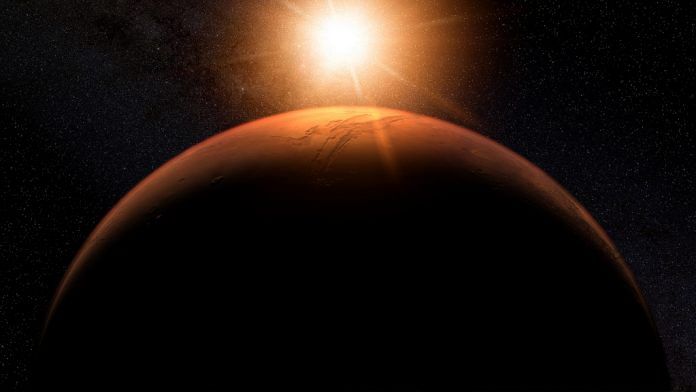Bengaluru: Scientists have detected a quake on Mars for the first time, the French space agency CNES announced Tuesday.
NASA’s InSight robotic lander on Mars detected the ‘marsquake’ in a historic reading that takes us one step closer to understanding the interior of the silent planet.
While NASA-JPL leads the InSight mission, the SEIS (Seismic Experiment for Interior Structure) instrument, which detected the quake, was provided to InSight by CNES.
The detection of the quake has come in the form of a rumbling from within the silent planet. There were four readings, of which one was confirmed to be a quake, said CNES.
The InSight mission
The InSights mission’s objective is to help understand the interior of Mars and thus its formation and evolution. It attempts to meet this objective through a number of instruments on board.
For example, the French instrument SEIS is used to detect marsquakes and measure the thickness of the Martian crust. The German instrument Heat Flow and Physical Properties Package (HP3) burrows inside the Martian soil to measure heat transfer and understand the temperature of the core. And, the American Rotation and Interior Structure Experiment (RISE) is a radio equipment that provides more accurate measurements of the planet’s rotation and thus its wobble and interior mass, and so on.
Also read: Scientists detect the first-ever molecule of the universe
The readings
To prevent external noise from interfering with the readings, the SEIS instrument, positioned near the Martian equator, was placed inside a dome that keeps out faint noises from the wind and infamous Martian dust storms.
The instrument has taken four readings so far — on 14 March, 6 April, 10 April, and 11 April. The reading of 6 April was confirmed as a quake.
“InSight’s first readings carry on the science that began with NASA’s Apollo missions,” said InSight Principal Investigator Bruce Banerdt of NASA’s Jet Propulsion Laboratory (JPL) in Pasadena, California.
“We’ve been collecting background noise up until now, but this first event officially kicks off a new field: Martian seismology,” he added.
Significance of the observation
On Earth, quakes are caused because of tectonic motion, when the plates slide against or apart from one another. On Mars, there is no tectonic activity. Instead, planetary scientists estimated that there was pressure and gas build-up inside the planet as the core and mantle expand and contract while the planet’s interior gradually cools down over the course of millions of years. Additionally, slipping and sliding of rocks and collapsing structures on the surface also produce discernible quakes.
There is a precedent for this reasoning. When the Apollo astronauts visited the moon, they installed seismometers and recorded thousands of small quakes, indicating that the moon is seismically active.
Scientists have been wondering for decades whether Mars is geologically active or not. Owing to its small size, the planet cools down to a great degree much faster than Earth, which still has a lot of hot activity in its interior, as evidenced by volcanic eruptions, among other things.
Mars also has the solar system’s biggest volcano, Olympus Mons, which has, however, been silent for millions of years.
Mars might have had tectonic plates at some point, but it surely does not have them today. However, huge rocks on and under the surface of the planet may still slide around because of gravity, and heat from the core may cause expansion, releasing gas and energy in the form of quakes.
Even sliding rocks below the surface will produce rumbles that can be detected by an instrument as sensitive as SEIS, on a planet as silent as Mars, when there are no winds.
Moonquakes and marsquakes are similar
Quakes on each of the solar system’s three rocky bodies — Earth, Moon and Mars — that are currently being seismically monitored are different.
The Earth is most different owing to tectonic activity, but moonquakes and marsquakes have a similar profile.
On the moon, quakes are caused by a multitude of reasons: The Earth’s gravitational tug on the surface of the moon, the extreme changes in temperature between day and night, meteorite impacts, collapse of rocky or other soil structures on the surface, and more. Unlike Earth, there is no water under the lunar surface that can absorb energy and sound, so these seismic waves travel around the lunar body for hours. The marsquake was similar.
Studying the waveforms of marsquakes enable scientists to figure out how the seismic wave travelled and through what kind of material. It helps understand the porosity of rocks, the way they are aligned, the thickness of the mantle, how heat shrinks and expands surface geology, and more.
Also read: Saturn’s moon Titan has lakes of methane over 100 metres deep, and they’re much like ours






